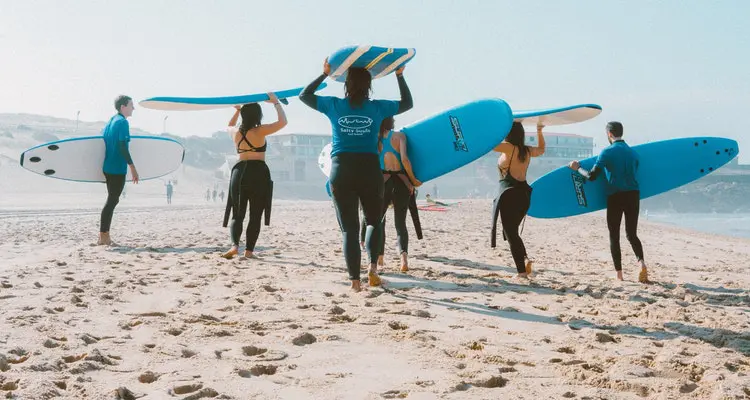This is a little bit like asking how long a piece of string is. It’s incredibly subjective and depends on so many variants. If we were pushed to give a short answer, then we’d day anywhere between 3 days and several weeks.
But for some, learning to surf properly can even take several months. The time is takes will depend on your individual ability, the equipment you use, your instructor (if you choose to use one), and the surf conditions.

Your ability level
There is little doubt that a person who has good balance and has done sports like skateboarding, snowboarding, skiing etc will naturally be predisposed to surfing more than people who have not done such sports before.
The one thing all newcomers share in common when learning is the difficulty in paddling into a wave. Regardless of how good one may be at another board sport, the paddling part of surfing is critical when it comes to advancing beyond the learning stage.
Being proficient at paddling directly correlates to both fitness and technique, with both not being mutually exclusive. In order to exhibit good paddling technique it’s vital that one has a good base level of fitness.
Choosing the right equipment
The time it takes you to learn to surf will also very depend on the equipment you choose. Most notably the surfboard, but also the wetsuit. It is advisable to start off on a very long surfboard which is of relatively high volume. This will make paddling into waves much easier. It will also be more stable standing up on the board.

We strongly advise starting out on a foam surfboard as they are easier to handle that traditional PU surfboards in the water. They also float on top of the water more than a PU board which reduces the chance of nose diving when taking off on a wave – a very common beginner problem.
If you are learning to surf in water which requires a wetsuit be sure to hire a wetsuit which will fit you properly. Too big and the wetsuit is going to weigh you down in the water.
Too small and the wetsuit will be too restrictive which will make paddling very difficult. Ideally, the best way to find a proper fitting wetsuit is to buy one yourself.
The surf instructor
Some people will teach themselves to surf, but the majority will take a surf lesson to start with. Some instructors teach surfing using a cookie cutter approach. This means that every student receives the same type of instruction.
This doesn’t really make sense considering we are all different and pick things up differently. A good instructor will adjust their style of teaching for the type of student they have.

They will teach a teenager very differently to how they would teach someone in their 50’s. For younger people it’s more about feel and learning from watching. For older people it’s often more about learning the exact technique.
The surf instructor is a tremendously important part of the experience of learning to surf. Your instructor will either impart their knowledge correctly so that you can learn to surf in the shortest time possible.
Moreover, a good surf instructor will be able to instil enough confidence in someone to believe they can learn to surf in the shortest time possible.
The surf conditions
These are often overlooked when it comes to learning to surf, but in fact are very important. Firstly, you need to make sure you choose the right location to surf to at. Don’t go a reef or a point break and expect to return 3 hours later with the surfing string in your bow.
Be sure to choose a beach break with waves that are conducive to learning. Beach breaks are optimal for learning at because you can normally comfortably stand in the water whilst you learn. This is really important as paddling can get very tiring.

Beach breaks also mean that you won’t have to worry about dinging or scratching your surfboard on rocks that are often prominent on reef breaks, and sometimes even point breaks. If you are unsure of what the differences are between a beach, reef and point break are then check out our blog post on the different types of waves.
The ideal beach break is one which has a slow, flattish waves breaking. This will give you time to stand up on the wave. Moreover the wave will not be immensely powerful making it easier to duck dive under, and generally less intimidating to be around.
Finally, be sure to pick the conditions at your chosen beach break. Ideal conditions would be waves of 1-2 foot with no wind or a light offshore breeze blowing. If you can start your first surf in such conditions then this will bode very well in you learning to surf in the shortest time possible.
Conclusion
With all of the above-mentioned factors, it quickly becomes clear that knowing exactly how long it is going to take to learn to surf is more complex than originally considered. Some fast learners, with a flair for board sports can successfully pop up and ride an unbroken wave in a matter of hours.
For others the dream of riding an unbroken wave may take weeks or even months of practice. Once you do experience that first real ride on an unbroken wave, we’re sure that you’ll be hooked on surfing for the rest of your life.